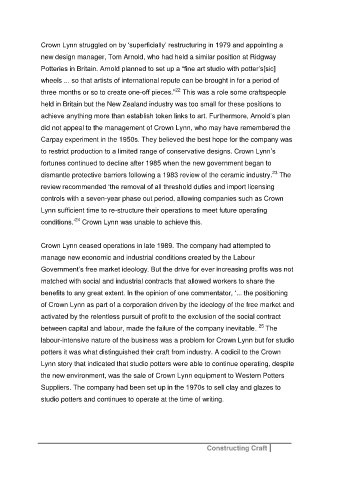Page 243 - Constructing Craft
P. 243
Crown Lynn struggled on by ‘superficially’ restructuring in 1979 and appointing a
new design manager, Tom Arnold, who had held a similar position at Ridgway
Potteries in Britain. Arnold planned to set up a “fine art studio with potter’s[sic]
wheels ... so that artists of international repute can be brought in for a period of
22
three months or so to create one-off pieces.” This was a role some craftspeople
held in Britain but the New Zealand industry was too small for these positions to
achieve anything more than establish token links to art. Furthermore, Arnold’s plan
did not appeal to the management of Crown Lynn, who may have remembered the
Carpay experiment in the 1950s. They believed the best hope for the company was
to restrict production to a limited range of conservative designs. Crown Lynn’s
fortunes continued to decline after 1985 when the new government began to
23
dismantle protective barriers following a 1983 review of the ceramic industry. The
review recommended ‘the removal of all threshold duties and import licensing
controls with a seven-year phase out period, allowing companies such as Crown
Lynn sufficient time to re-structure their operations to meet future operating
24
conditions.’ Crown Lynn was unable to achieve this.
Crown Lynn ceased operations in late 1989. The company had attempted to
manage new economic and industrial conditions created by the Labour
Government’s free market ideology. But the drive for ever increasing profits was not
matched with social and industrial contracts that allowed workers to share the
benefits to any great extent. In the opinion of one commentator, ‘... the positioning
of Crown Lynn as part of a corporation driven by the ideology of the free market and
activated by the relentless pursuit of profit to the exclusion of the social contract
25
between capital and labour, made the failure of the company inevitable. The
labour-intensive nature of the business was a problem for Crown Lynn but for studio
potters it was what distinguished their craft from industry. A codicil to the Crown
Lynn story that indicated that studio potters were able to continue operating, despite
the new environment, was the sale of Crown Lynn equipment to Western Potters
Suppliers. The company had been set up in the 1970s to sell clay and glazes to
studio potters and continues to operate at the time of writing.
Constructing Craft

